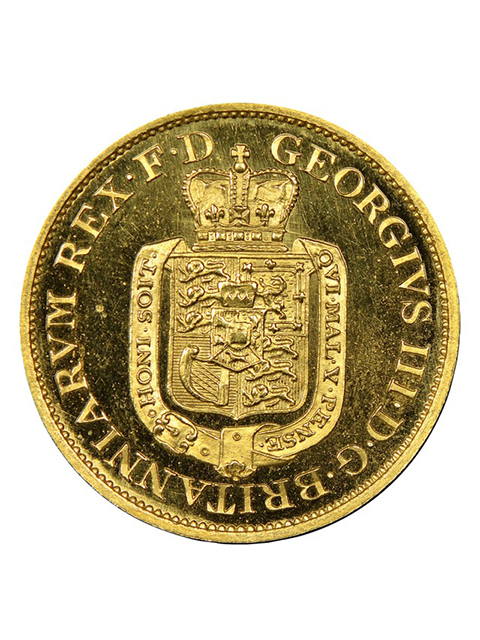(291)英国王「ジョージIII世」1813年 5 Taler金貨 NGC/PCGS 唯一の最高鑑定 「PR66カメオ」Ex Dr Mooreコレクション!! SOLD OUT
鋳造年:1813年
継続鋳造: 1813年〜1815年
鋳造地:(英国)ロンドン、
Royal Mint (Tower Hill) London
額面: 5 Taler
刻印師: Thomas WYON
重量: 6,6グラム
(スラブ合わせて46,6グラム)
金品位: 896/1000
直径:23ミリ
表面: GEORGIVS III · D · G · BRITANNIARVM REX · F · D
裏面: * V * THALER *1813* (T.W)
BRUNSVICENS ET LVNEBVRG DVX · S · R · I · A · T · ET · E ·
NGC鑑定番号: 2062760-028
NGC鑑定結果:「PR66 CAMEO」
専門書: KM101, Fr-619, D./S.-85
NGC最新スラブ(2022年5月現在)
発売日2022年5月17日
本品の刻印師「Thomas WYON」について
1792年生まれで、1815年(23歳の異例の若さで)英国ミントの「総監師」におめでたく任命されます。
惜しくも、結核により2年後(没25歳)他界。
「ウナとライオン」など有名になったWilliam WyonはThomas Wyonの3歳年下従兄弟にあたります。
あれほど、若死にしていなければ、Wyon家の「エース」になったのではないか?
King of England « George III »
ジョージ3世(George III、1738年6月4日 - 1820年1月29日)は、ハノーヴァー家第3代目のイギリス国王(在位:1760年10月25日 - 1820年1月29日)。
1760年10月25日から1800年12月31日まではグレートブリテン国王兼アイルランド国王であり、1801年1月1日に両国が合同してから崩御するまでは、グレートブリテン及びアイルランド連合王国国王。
また同時に、神聖ローマ帝国のハノーファー選帝侯でもあり、1814年10月12日以後はハノーファー王ゲオルク3世(Georg III)に昇格した。ハノーヴァー家の国王だったが、先代・先々代と異なりイギリス生まれで母語は英語であり、ハノーファーへは一度も訪れなかった。
ジョージ3世の寿命と治世の長さはそれまでの全てのイギリス国王よりも長く、ヨーロッパからアフリカ、アメリカ、アジアまで拡大した多くの軍事紛争に彩られた。治世初期にはグレートブリテン王国が七年戦争でフランス王国に勝利、北アメリカとインドにおけるヨーロッパ諸国の勢力の間で支配的な勢力となった。
しかし、アメリカ独立戦争では敗北して13植民地はじめ北米の多くの植民地を失った。1793年からは革命時期とナポレオンの帝政時期のフランスとの戦争に突入、1815年のワーテルローの戦いまで続いた。
治世後期は、精神疾患に繰り返し悩まされた。ポルフィリン症を患っていたとされたが、病気の原因は不明のままである。1810年に病気が再発、回復の兆しもなかったため摂政が任命され、長男のジョージ王太子が摂政王太子として統治した。1820年1月29日にジョージ3世が81歳で崩御すると、摂政王太子は57歳でジョージ4世として王位を継承した。
ジョージ3世の一生に関する史的分析において、様々な意見が様変わりした。これは伝記作家が入手可能な史料、そして彼ら自身の偏見に起因する。20世紀の後半に再評価されるまで、アメリカ合衆国におけるジョージ3世の評価は暴君そのものであったが、イギリスにおいては「(イギリス帝国による)帝国主義の失敗のスケープゴート」になった。
City of HANNOVER
中世にライネ川岸に建設された(元の名前「Honovere」は「高い堤」と訳される)。元は漁村だったが、13世紀には大きな町になりつつあった。14世紀には教会や市庁舎、3つの市門のある城壁もできた。この頃、ハンザ同盟の一員として繁栄した。1636年にブラウンシュヴァイク=リューネブルク公国の一部であるカレンベルク侯領を受け継いだゲオルクが首都をハノーファーに移し、ブラウンシュヴァイク=カレンベルク公領の首都となった。1692年、エルンスト・アウグストが選帝侯となったことにより、彼の公領はブラウンシュヴァイク=リューネブルク選帝侯領、通称ハノーファー選帝侯領となった。
1714年、ハノーファー選帝侯ゲオルク1世はイギリス国王ジョージ1世として即位した。イギリスとの関係が深いため、イギリス風の建物が残る。ナポレオン戦争後にハノーファー選帝侯領はハノーファー王国となる(1866年まで )。
第二次世界大戦においては、空襲を受け、町の3分の2が焼失した。
2019年の市長選挙で緑の党でトルコ系のベリト・オナイが当選した。トルコ系が大都市圏の市長になるのは初のことである。
Hannover.
George III of England gold Proof 5 Taler 1813-TW PR66 Cameo NGC, London mint, KM101, Fr-619, D./S.-85.
Thomas Wyon as die-cutter.
A beautifully struck example of this rarity, with frost-tipped devices set upon watery mirrors.
While evidence of light handling is present in the fields, it does little to detract from the overall appealing nature of this Gem, as the eye is continually focused on the lemon-tinged flash that beams from the fields and the bold renderings across both sides.
Likely among the finest extant, and currently unrivaled in this certified designation.
From the D. Moore Collection
Thomas Wyon the Younger (1792 – 22/23 September 1817) was an English medallist and chief engraver at the Royal Mint.
Wyon was born in Birmingham. He was apprenticed to his father, Thomas Wyon (1767–1830), the chief engraver of the King's seals, who taught him the art of engraving on steel; subsequently he studied at the sculpture school of the Royal Academy in London, where he earned silver medals in both the antique and the life class.[1] In 1809, he struck his first medal, presented to Lieutenant Pearce, R.N. In 1810, he won the gold medal of the Society of Arts for medal engraving; the die, representing a head of Isis, was purchased by the society and used for striking its prize medals. From this period he produced many medals for schools, societies, Pitt clubs, and other institutions.[2]
On 20 November 1811, Wyon was appointed probationary engraver to the Royal Mint, and was employed in making the bank tokens for England and Ireland, and coins for the British colonies and for Hanover. He also engraved his medal commemorative of the peace and his Manchester Pitt medal.
On 13 Oct. 1815 he was appointed chief engraver to the mint, being then only twenty-three. The next year he brought out the new silver coinage for the United Kingdom (half-crown, shilling, and sixpence), designing the reverses himself. In 1817 he struck the maundy money, and began to make his pattern crown-piece in rivalry of Thomas Simon.
Signs of consumption now began to appear, and Wyon—a modest and talented artist—died on 23 (or 22) September 1817 at the Priory Farmhouse, near Hastings. He was buried in the graveyard attached to Christ Church, Southwark.
His younger brother, Benjamin Wyon (1802–1858), his nephews, Joseph Shepherd Wyon (1836–1873) and Alfred Benjamin Wyon (1837–1884), and his cousin, William Wyon (1795–1851) were also distinguished medallists.
